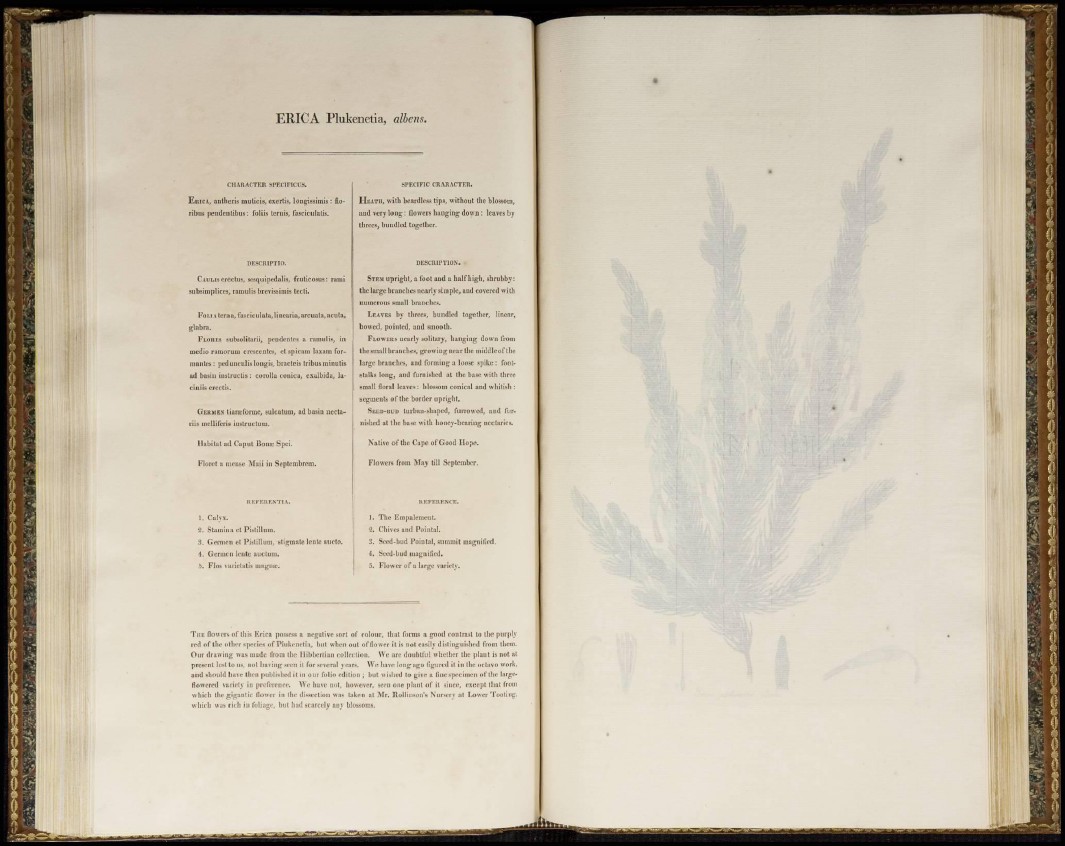
ERICA Plukenetia, aliens.
CHARACTER SPEC1FICUS.
ERICA, antheris am tic is, cxertis, longissimis: floribus
pendentibus: folds ternis, fasciculatis.
DESCRIPTIO.
CAULIS crcctus, sesquipedal is, frulicosus: rami
subsimplices, ramulis brevissimis tecti.
FOLIA lerna, fasciculata,linearía,arcuata,acuta,
glabra.
FLORES subsolitarii, pendentes a ramulis, in
medio ramorum crcseenfes, et spícain laxam formantes:
pedunculis longis, bractcis tribus mi nut is
ad basin instructis: corolla cónica, esalbida, Iaciniis
crectis.
GERMEN t¡ara>forme, sulcatum, ad basin nectariis
uiclliferis ínstructum.
Habitat ad Capul Bona: Spei.
Floret a uiense Maii in Septcmbrem.
R E F E R E N T ! A.
1 . Calyx.
2 . Stamina ct Pistillum.
3. Germen ct Pistillum, stigmate lente aucto.
4. Germen lente auetuui.
ƒ>, Flos varietalis magna;.
SPECIFIC CRARACTER.
HEATH, with beardless tips, without the blossom,
and very long: flowers hanging down : leaves by
threes, bundled together.
DESCRIPTION.
STEM upright, a foot and a half high, shrubby:
the large branches nearly simple, and covered with
numerous small branches.
LEAVES by threes, bundled together, linear,
bowed, pointed, and smooth.
FLOWERS nearly solitary, hanging down from
the small branches, growing near the middle of the
large branches, and forming a loose spike: footstalks
long, and furnished at the base with three
small floral leaves : blossom conical and whitish :
segments of the border upright.
SEED-BUD turban-shaped, furrowed, and furnished
at the base with honey-bearing nectaries,
Native of the Cape of Good Hope.
Flowers from May till September.
R E F E R E N C E .
1. The Empalement.
2 . Chives and Pointai.
3. Seed-bud Pointai, summit magnified,
4. Seed-bud magnified.
5. Flower of a large variety.
TITE flowers of this Erica possess a negative sort of colour, that forms a good contrast to the purply
red of the oilier species of Plukenetia, but when out of flower it is not easily distinguished from them.
Our drawing was made from the Hibbertian collection. We are doubtful whether the plant is not at
present lost to us, not having seen it for several years. We have lung ago figured it in the octavo work,
and should have then published it in our folio edition ; but wished to give a fine specimen of the largeflowered
variety in preference. We have not, however, seen one plant of it since, except that from
which the gigantic flower in the dissection was taken at Mr. Rollinson's Nursery at Lower Tooling',
which was rich in foliage, but had scarcely any blossoms.